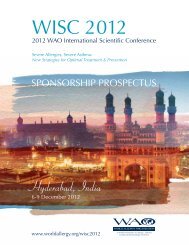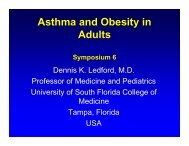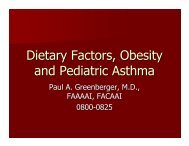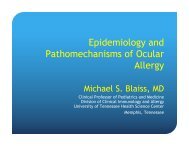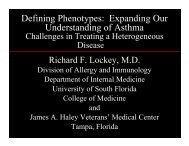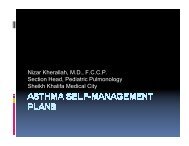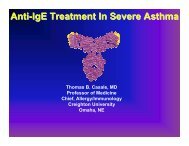Dubai Final-v20.indd - World Allergy Organization
Dubai Final-v20.indd - World Allergy Organization
Dubai Final-v20.indd - World Allergy Organization
You also want an ePaper? Increase the reach of your titles
YUMPU automatically turns print PDFs into web optimized ePapers that Google loves.
ABstrACts<br />
ABstrACts<br />
1316<br />
CHLAMYDOPHILA PNEUMONIAE-inFECTED HUman PEriPHEral mononUClEar CEllS rESiST CorTiCoSTEroiD- inDUCED<br />
SUPPrESSion oF mETalloProTEinaSE-9 anD TiSSUE inHiBiTor mETalloProTEinaSE-1 SECrETion<br />
Park, C. s. 1 , Kim, t. 2 , moon, K. 3 , Bae, Y. 2 , lee, Y. s. 2 , Jang, m. K. 3 , moon, H. 2 and Cho, Y. s. 2<br />
1 2 Department of internal medicine, inje university Heaundae Paik Hospital, Busan, south Korea. Department of <strong>Allergy</strong> and Clinical<br />
immunology, Asan medical Center, University of Ulsan College of medicine, seoul, south Korea. 3Asan institute for life science,<br />
seoul, south Korea.<br />
Background: it has been suggested that Chlamydophila pneumoniae infection contributes to the development of severe asthma.<br />
the major characteristics of severe asthma include a reduced response to corticosteroid treatment and progressive airway<br />
remodeling in which an imbalance of metalloproteinase-9 (mmP-9) and tissue inhibitor metalloproteinase-1 (timP-1) is believed<br />
to have an important role. We hypothesized that C. pneumoniae infection affects the secretion of mmP-9 and timP-1 and induces<br />
altered responsiveness to corticosteroids in inflammatory cells.<br />
methods: Human peripheral blood mononuclear cells (PBmCs) were cultured in vitro in the presence or absence of C. pneumonia<br />
infection. Dexamethasone was used in each experiment to assess the responsiveness to the corticosteroid. the values of secreted<br />
mmP-9 and timP-1 were measured by ElisA. to evaluate the underlying mechanism, the expression of human glucocorticoid<br />
receptor (gr)-β, known as an endogenous antidote for gr, was observed in PBmCs with or without C. pneumoniae infection using<br />
immunohistochemistry.<br />
results: the secretion of mmP-9 and timP-1 was remarkably suppressed by corticosteroid treatment in PBmCs without<br />
C. pneumoniae infection. in C. pneumoniea-infected PBmCs, the suppressed secretion of mmP-9 by the corticosteroid was<br />
significantly inhibited, while the level of timP-1 secretion did not change compared with those levels in untreated PBmCs.<br />
therefore, the molar ratio of secreted mmP-9/timP-1 was decreased by C. pneumonia infection and was more exaggerated under<br />
corticosteroid treatment. the expression of gr-β was significantly increased in C. pneumoniae-infected PBmCs.<br />
Conclusion: C. pneumoniae infection in inflammatory cells may induce altered secretion of tissue enzymes associated with airway<br />
remodeling through a decreased responsiveness to corticosteroids and may be linked to the pathogenesis of severe asthma.<br />
Key words: Asthma, Chlamydophila pneumoniae, Peripheral blood mononuclear cells, mmP-9, timP-1, glucocorticoid receptor (gr)<br />
- β<br />
1317<br />
EFFECTS oF TraFFiC air PollUTion on rESPiraTorY HEalTH anD allErgiES in EgYPTian SCHoolCHilDrEn<br />
shamssain, m. 1 , Al Qerem, W. 2 , mcgarry, K. 1 and neshat, l. 1<br />
1 2 Pharmacy, Health and Wellbeing, University of sunderland, U.K, sunderland, United Kingdom. Pharmacy, Health and Wellbeing,<br />
University of sunderland, sunderland, United Kingdom.<br />
Background<br />
studies suggest that traffic exposures can influence asthma and allergic symptoms among children; air pollution is associated with<br />
exacerbation of asthma symptoms in children with asthma. there has been few studies about the susceptibility of subgroups and<br />
on new onset asthma.the objective of the study is to investigate the effects of traffic air pollution on allergies with emphasis on<br />
gender differences in the respiratory effects of air pollution.<br />
methods<br />
We studied 1400 schoolchildren from two locations in Egypt: Cairo with high level of air pollution and shbeen Al Koom in the<br />
Delata with low level of air pollution. lung function testing was done by the Vitalograph spirometer. the Arabic version of isAAC<br />
questionnaire was used (the international study of Asthma and Allergies in Childhood). Air pollution measurements were collected<br />
from the government sites in both locations.<br />
results<br />
mean values of sO2, nO2, Ozone, CO, and Pm10 in Cairo were significantly lower than shbeen Al Koom (39.0 vs 17.0;62.8 vs<br />
55.8 ug/m3; 93.0 vs 28.8 ug/m3; 3.0 vs 1.3 mg/m3; and 263.5 vs 94.0 ug/m3, respectively. Forced vital capacity (FVC), forced<br />
expiratory volume in the first second (FEV1) and peak expiratory flow rate (PEFr) were lower in children in Cairo compared to shben<br />
Al Koom (1.99 vs 2.03 l; 1.70 vs 1.79 l; and 204.4 vs 207.4 l/min, respectively. the prevalence rates of current wheeze, asthma,<br />
rhinitis, hay fever and eczema in Cairo were higher than shbeen Al Koom (6.9 vs 5.6% ; 5.5 vs 3.3%; 24.2 vs 17.9; 9.5 vs 6.4%;<br />
and 9.1 vs 5.6% , respectively. the prevalence rates of ever rhinitis were 6.0% and 3.0% higher in boys and girls in Cairo compared<br />
to shbeen Al Koom, respectively. Children who developed rash less than 2 years of age were 2.0% and 5.0% higher in boys and<br />
girls in Cairo compared to shbeen Al Koom, respectively.<br />
www.worldallergy.org 106<br />
FinAl PrOgrAm



